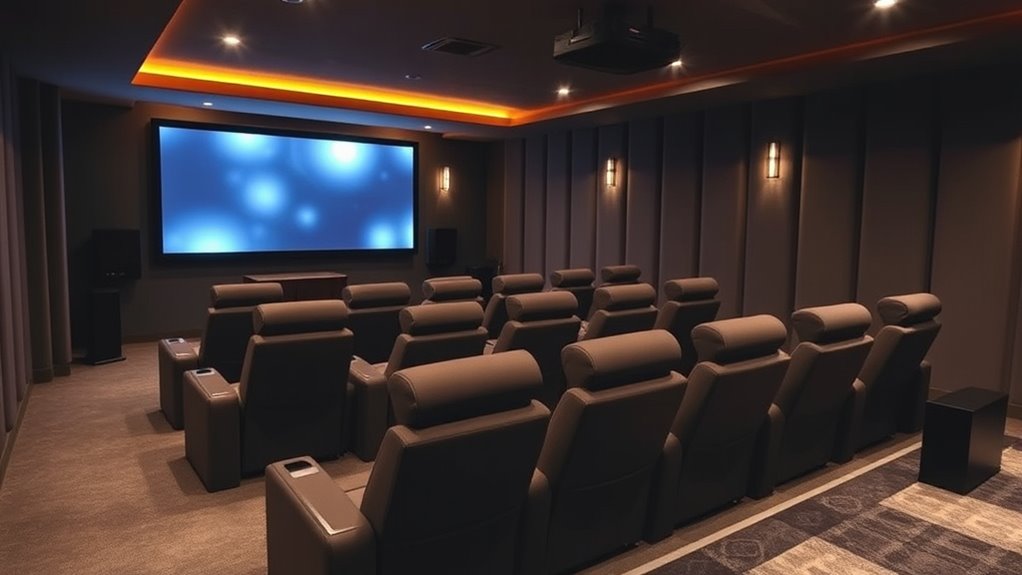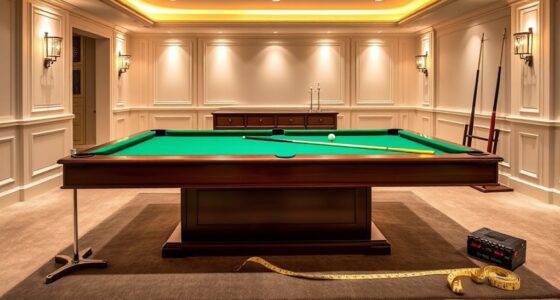Building a basement home theater on any budget is totally doable with smart planning. Start by evaluating your space and addressing dampness and insulation to improve comfort and sound. Use cost-effective soundproofing options like acoustic tiles and select equipment within your budget, focusing on essentials like a good projector and comfortable seating. Prioritize structural upgrades and electrical work early. With careful choices and some inspiration, you’ll discover how to create a great home theater without overspending.
Key Takeaways
- Assess and address waterproofing and insulation first to create a dry, comfortable foundation.
- Use cost-effective soundproofing materials like acoustic panels and foam to improve acoustics affordably.
- Budget approximately $250 per sq ft, and prioritize essential equipment within your financial limits.
- Opt for in-wall or ceiling-mounted speakers and a projector with at least 1,000 lumens for optimal experience.
- Complete all structural, electrical, and waterproofing work before decorating to ensure safety and compliance.

Building a basement home theater is an achievable project for any budget, whether you have a small space or a large one to work with. The first thing you’ll want to consider is the layout and condition of your basement. A smaller space can help keep costs down, but it might limit your design options. If your basement has dampness issues or insulation problems, addressing these is essential before installing your theater. Professional waterproofing can cost between $2,000 and $10,000, but neglecting this step could lead to ongoing problems. Making sure the space is dry and well-insulated not only protects your investment but also enhances comfort and sound quality. Proper insulation also improves energy efficiency and reduces noise transfer between rooms.
Soundproofing is another vital factor. In basements, you’ll need to block noise from escaping to other parts of the house and prevent external sounds from interfering with your movie experience. Acoustic treatments, such as acoustic tiles or panels, typically cost between $1,000 and $2,500. These materials improve sound clarity and minimize echoes, making your theater more immersive. Additionally, verify that your basement’s structure is sound and suitable for residential use. Structural improvements, especially waterproofing and insulation upgrades, should be completed before decorating to avoid costly modifications later. If you’re unsure of your skills, hiring professionals for these tasks can guarantee safety and durability, though it adds to your overall costs.
Budgeting wisely helps you get the most out of your project. Building a room from scratch usually costs around $250 per square foot, depending on location and material choices. To keep costs under $10,000, allocate no more than 30% of your budget for the display equipment. Soundproofing materials and acoustic panels should take up about 5-10% of your budget. Don’t forget electrical needs; additional power and wiring should be limited to 5-8% of your funds. Exploring financing options can assist if your DIY skills are limited or if you want higher-end equipment. Careful planning and research are key to balancing quality and affordability. Additionally, understanding cost-effective design strategies can help maximize your budget without sacrificing quality.
When it comes to equipment, choose a projector with at least 1,000 ANSI lumens for the best results in a controlled basement environment. In-wall or ceiling-mounted speakers are ideal for a clean look and superior sound. Investing in comfortable seating, like leather loungers, enhances your viewing experience. Select a screen size that fits your room and seating arrangement, and consider acoustic treatments to improve sound quality further. Proper room design, including sight lines and speaker placement, is key to creating an immersive theater. Use soundproofing materials such as acoustic tiles and insulation to keep the noise contained.
Finally, all structural work, including waterproofing, insulation, and electrical upgrades, should be completed before decorating. Depending on your skills, you may want to hire professionals for these tasks. Calculate the costs for materials like carpeting, wall coverings, and paint based on your space size, and get estimates for local labor costs. Don’t forget to secure any necessary permits and inspections to ensure your project complies with local codes. With careful planning and strategic budgeting, building your basement home theater can be a rewarding and achievable project for any budget.
Frequently Asked Questions
What Are the Best Soundproofing Options for a Basement Theater?
You want the best soundproofing options for your basement theater. Start by sealing gaps around walls, doors, and outlets to prevent leaks. Use double wall systems with insulation and multiple drywall layers for effective soundproofing. Incorporate decoupled ceilings with resilient channels and add acoustic panels for absorption. Consider soundproofing floors and creating sealed speaker boxes. Combining these methods guarantees a quieter, more immersive theater experience.
How Can I Improve Basement Lighting Without Increasing Costs?
Imagine dimming the harsh glare and creating a cozy, inviting glow in your basement. To do this without extra costs, install wall-mounted sconces to cast soft, focused light and control it with dimmers for the perfect ambiance. Add LED strip lights behind furniture or along floors for subtle accents. Use dark paint and soft textures to absorb excess light, making your space feel warmer and more cinematic without spending a dime.
What Safety Precautions Are Necessary During Basement Renovation?
When you’re renovating your basement, safety precautions are key. You should inspect the structure for cracks or uneven flooring to prevent collapse. Address moisture issues with waterproofing and install sump pumps to keep the space dry. Test for radon and ensure proper ventilation to avoid harmful gases. Follow electrical codes, use GFCI outlets, and keep fire extinguishers accessible. Always maintain clear exits and prioritize safety to protect yourself during the project.
How Do I Choose the Right Projector for My Budget?
Picture yourself in a cozy basement, the screen glowing vividly before you. To pick the right projector, first picture your space and budget. If you’re on a tight budget, opt for a 720p or 1080p LCD or DLP model; they’re affordable but may lack deep blacks. For a richer experience, consider a mid-range 4K projector with better contrast. Match brightness to your ambient light, and choose a light source that suits your long-term needs.
Are There DIY Alternatives to Professional Acoustic Treatments?
You’re wondering if DIY alternatives can replace professional acoustic treatments. Yes, they can, and you can make effective options using household items. For example, build simple panels with insulation and fabric, hang heavy curtains or blankets to absorb sound, use bookshelves for diffusion, and place rugs or furniture to reduce reflections. These methods can substantially improve sound quality without breaking the bank, especially when combined with strategic placement.
Conclusion
Now that you know the essentials, imagine settling in for your favorite film, surrounded by the perfect sound and picture—all on your budget. But the real question is, what’s the final touch that will truly transform your basement into an unforgettable home theater? As you stand on the brink of your project’s next step, the secret ingredient awaits. Are you ready to turn your vision into reality and experience cinematic magic like never before?









